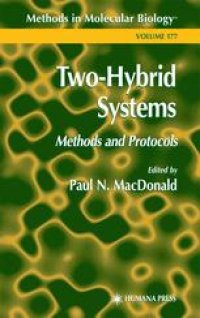
Ebook: Two-Hybrid Systems: Methods and Protocols
- Tags: Cell Biology
- Series: Methods in Molecular Biology 177
- Year: 2001
- Publisher: Humana Press
- Edition: 1
- Language: English
- pdf
The yeast two-hybrid system is one of the most widely used and productive techniques available for investigating the macromolecular interactions that affect virtually all biological processes. In Two-Hybrid Systems: Methods and Protocols, Paul N. MacDonald has assembled a collection of these powerful molecular tools for examining and characterizing protein-protein, protein-DNA, and protein-RNA interactions. The techniques range from the most basic (introducing plasmids into yeasts, interaction assays, and recovering the plasmids from yeast) to the most advanced alternative strategies (involving one-hybrid, split two-hybrid, three-hybrid, membrane recruitment systems, and mammalian systems). Methods are also provided for dealing with the well-known problems of artifacts and false positives and for identifying the interacting partners in important biological systems, including the Smad and nuclear receptor pathways. To ensure ready reproducibility and robust results, each technique is described in step-by-step detail by researchers who employ it regularly.
Comprehensive and highly practical, Two-Hybrid Systems: Methods and Protocols not only reveals how the great variety of plasmid vectors and approaches may be optimally deployed, but also quickly empowers novices to establish two-hybrid systems in their laboratories, and experienced researchers to expand their repertoire of techniques.
The yeast two-hybrid system is one of the most widely used and productive techniques available for investigating the macromolecular interactions that affect virtually all biological processes. In Two-Hybrid Systems: Methods and Protocols, Paul N. MacDonald has assembled a collection of these powerful molecular tools for examining and characterizing protein-protein, protein-DNA, and protein-RNA interactions. The techniques range from the most basic (introducing plasmids into yeasts, interaction assays, and recovering the plasmids from yeast) to the most advanced alternative strategies (involving one-hybrid, split two-hybrid, three-hybrid, membrane recruitment systems, and mammalian systems). Methods are also provided for dealing with the well-known problems of artifacts and false positives and for identifying the interacting partners in important biological systems, including the Smad and nuclear receptor pathways. To ensure ready reproducibility and robust results, each technique is described in step-by-step detail by researchers who employ it regularly.
Comprehensive and highly practical, Two-Hybrid Systems: Methods and Protocols not only reveals how the great variety of plasmid vectors and approaches may be optimally deployed, but also quickly empowers novices to establish two-hybrid systems in their laboratories, and experienced researchers to expand their repertoire of techniques.
The yeast two-hybrid system is one of the most widely used and productive techniques available for investigating the macromolecular interactions that affect virtually all biological processes. In Two-Hybrid Systems: Methods and Protocols, Paul N. MacDonald has assembled a collection of these powerful molecular tools for examining and characterizing protein-protein, protein-DNA, and protein-RNA interactions. The techniques range from the most basic (introducing plasmids into yeasts, interaction assays, and recovering the plasmids from yeast) to the most advanced alternative strategies (involving one-hybrid, split two-hybrid, three-hybrid, membrane recruitment systems, and mammalian systems). Methods are also provided for dealing with the well-known problems of artifacts and false positives and for identifying the interacting partners in important biological systems, including the Smad and nuclear receptor pathways. To ensure ready reproducibility and robust results, each technique is described in step-by-step detail by researchers who employ it regularly.
Comprehensive and highly practical, Two-Hybrid Systems: Methods and Protocols not only reveals how the great variety of plasmid vectors and approaches may be optimally deployed, but also quickly empowers novices to establish two-hybrid systems in their laboratories, and experienced researchers to expand their repertoire of techniques.
Content:
Front Matter....Pages i-xii
Front Matter....Pages 1-1
Front Matter....Pages 3-8
Front Matter....Pages 9-14
Front Matter....Pages 15-39
Back Matter....Pages 41-84
....Pages 85-97